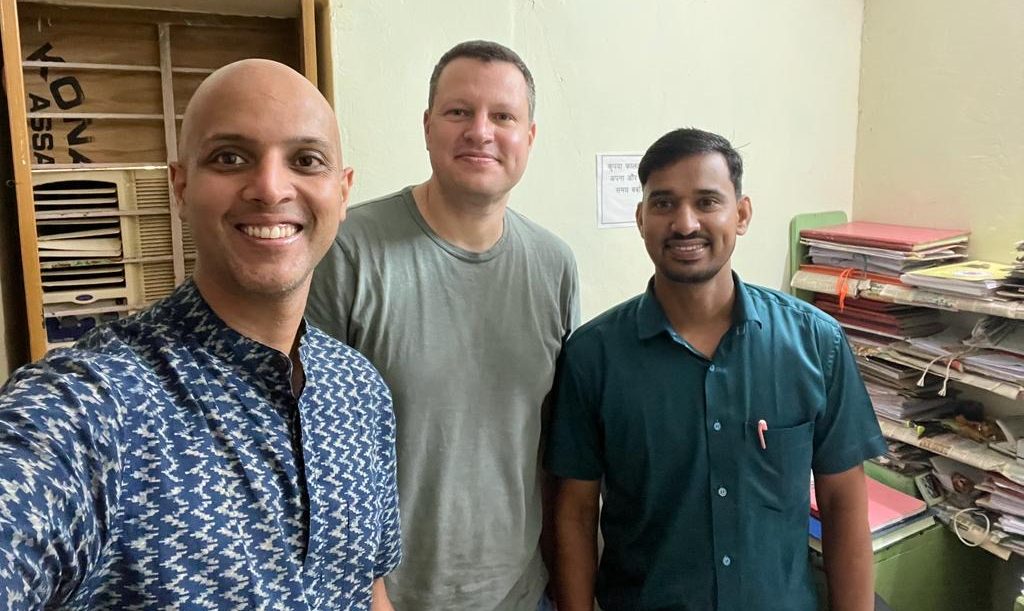Penn Global project looks at India’s urban future

Tariq Thachil, Adam Auerbach, with the revenue officer in Sambhar, Rajasthan. (Image Courtesy: Tariq Thachil)

The project could have real impact on policymakers and contribute to key challenges facing India and the world
Tariq Thachil, an Indian American political and social scientist, is studying the political consequences of urbanization in India through a two-year project supported by Penn Global and the Center for the Advanced Study of India.
Over half of India’s urban population lives in towns with less than 500,000 people, notes Thachil, who is looking into the political workings of India’s rapidly urbanizing landscape through ‘Understanding India’s Urban Future’ project.
Read: Remaking urban space in India has led to dispossession of citizens: Jisha Menon (February 2, 2022)
When people think of Indian cities, they picture Mumbai or New Delhi, not small urban centers of which there is almost no data, he says according to a University of Pennsylvania news release.
There’s a lot of research on villages and big cities, but the small cities have been overlooked, says Thachil, a professor of political science, director of the Center for the Advanced Study of India (CASI), and the Madan Lal Sobti Professor for the Study of Contemporary India at the University of Pennsylvania.
Through natural growth, urban migration, and recategorization of what constitutes a “city,” India expects to add 416 million people to its cities by 2050—the largest projected increase in the world, he says.
“As one of five projects supported by the 2022 cohort of awards from Penn’s India Research and Engagement Fund, this project represents Penn’s commitment to engagement with India as a critical part of the University’s research, teaching, and service missions,” says Scott Moore, Director of China Programs and Strategic Initiatives at Penn Global.
“By adding to our understanding of urbanization and public administration, Thachil’s work strengthens Penn’s ability to contribute to key challenges facing India and the world.”
Urban growth is a worldwide trend, Thachil says. In India, urbanization dovetails a second development: the decentralization of power from the center to local governments. In 1992, India passed the 74th Constitutional Amendment Act, establishing municipalities as autonomous local governments. “What India did was this big experiment in devolving power from the central to the local level,” Thachil says.
The idea was that making local elected officials responsible for their own towns and cities would make for better governance. Officials are elected from the communities they represent and, in theory, are more accountable and responsive to community needs, Thachil says.
“There’s a lot of promise behind that. But what I wanted to know is: What’s actually been happening in these places?
“Have they delivered on this promise? Have they been doing what was intended?” he asks. “That’s what this project is motivated by: a very broad and deep dive.”
To find out, Thachil works with a team that includes Adam Auerbach of American University (with whom Thachil published a new book), 18 India-based researchers, and three others at Penn—an undergraduate, a PhD candidate, and a CASI postdoctoral fellow, according to the release.
Now, Thachil and his partners are in the data-collection phase of the project, beating the streets of approximately 180 small cities in the state of Rajasthan.
Thachil has personally visited 18. He flies out to do fieldwork in the summer, when Rajasthan’s clear skies heat up to above 104° Fahrenheit during the day, dropping quickly at night.
Deepaboli Chatterjee, a first-year PhD student studying political science, was part of a four-person team that did case studies in four different Rajasthani towns: two with approximately 25,000 residents and two with 35,000 to 40,000 residents.
In their research, Thachi’s team found that half of elected officials in Rajasthan’s small cities didn’t know they could collect taxes—which isn’t entirely the officials’ fault.
Through decentralization, India gave local municipalities a set of responsibilities and a slew of elected officials to carry them out. “But what is never fully done is the decentralization of financial autonomy and financial power, revenue-raising power,” Thachil says. And the financial powers they do have are sporadic, he says, “they’re sometimes given and taken away, given and taken away.”
The project could “have real impact on policymakers, on public discourse, and on other research in political science,” says Shikhar Singh, a postdoctoral research fellow at CASI, where he works on empirical analysis for the project: reading through field notes, synthesizing evidence, putting together arguments, writing up figures.
These small towns will be the epicenter of India’s population growth over the next few decades. The challenges of governance—which are closely related to the challenges of addressing climate change and caste, gender, and religious discrimination—will be played out in this arena, Singh says.
In the summer of 2024, Understanding India’s Urban Future will conclude with a workshop in New Delhi to convene scholars and graduate students working on India’s urban transition across different universities and research and policy institutes, and a separate presentation to key officials in Rajasthan’s state government who facilitated the work and expressed an interest in its findings. “The goal here is first and foremost to make sure our research is shared with officials who work in small towns,” Thachil says.
Read: Understanding India’s urban future (February 10, 2023)
Most of these towns have poor-quality roads and 95% don’t even have a partial sewage system, Thachil says. “They need everything.”
“Can we actually put systems in place where all these breakdowns aren’t happening?” he asks. “Where we have sewage systems rather than gutters overflowing? Where we have systems of electrification and water dispensing?”
Municipal governments are currently acting on read-and-react mode, Thachil says, addressing everyday crises with Band-Aids. This system, he says, is falling short.

